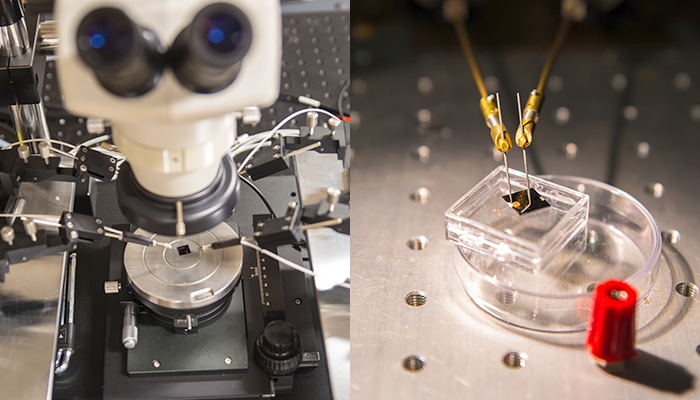Jan 11 2018
The internet of things is soon to arrive, but not until there are chips and components that can tackle the explosion of data that arrives with IoT. By 2020, nearly 50 billion industrial internet sensors will be placed all over the place.
A single autonomous device – a cleaning robot, a smart watch, or a driverless car – can generate gigabytes of data daily, whereas an airbus may have more than 10 000 sensors in just one wing.
 The probe-station device - the full instrument (left) and a closer view of the device connection (right), which measures the electrical responses of the basic components for computers mimicking the human brain. The tunnel junctions are on a thin film on the substrate plate. (Photo credit: Tapio Reinekoski)
The probe-station device - the full instrument (left) and a closer view of the device connection (right), which measures the electrical responses of the basic components for computers mimicking the human brain. The tunnel junctions are on a thin film on the substrate plate. (Photo credit: Tapio Reinekoski)
Two obstacles have to be overcome. First, current transistors in computer chips should be miniaturized to the size of just few nanometers; the issue is they will not function anymore then. Second, examining and storing exceptional amounts of data will require equally enormous quantities of energy. Sayani Majumdar, Academy Fellow at Aalto University, together with her colleagues, is designing technology to handle both problems.
Majumdar has with her colleagues developed and fabricated the standard building blocks of future components in what are known as “neuromorphic” computers inspired by the human brain. It is a field of research on which the world’s largest ICT companies and also the EU are investing heavily. However, no one has yet designed a nano-scale hardware architecture that could be scaled to industrial manufacture and application.
The technology and design of neuromorphic computing is advancing more rapidly than its rival revolution, quantum computing. There is already wide speculation both in academia and company R&D about ways to inscribe heavy computing capabilities in the hardware of smart phones, tablets and laptops. The key is to achieve the extreme energy-efficiency of a biological brain and mimic the way neural networks process information through electric impulses,
Sayani Majumdar, Academy Fellow
Basic components for computers that work like the brain
In their latest article in Advanced Functional Materials, Majumdar and her team reveal how they have fabricated a new type of “ferroelectric tunnel junctions”, that is, few-nanometer-thick ferroelectric thin films placed between two electrodes. They have abilities beyond current technologies and bode well for energy-efficient and consistent neuromorphic computing.
The junctions function in low voltages of below five volts and with a range of electrode materials – including silicon used in chips in several everyday electronics. They also can retain data for over 10 years without power and be mass-produced in normal conditions.
Tunnel junctions have up to this point typically been made of metal oxides and need 700 °C temperatures and high vacuums to fabricate. Ferroelectric materials also have lead which makes them – and all computers – a critical environmental hazard.
“Our junctions are made out of organic hydro-carbon materials and they would reduce the amount of toxic heavy metal waste in electronics. We can also make thousands of junctions a day in room temperature without them suffering from the water or oxygen in the air”, explains Majumdar.
Ferroelectric thin film components are great for neuromorphic computers because of their ability to shift between not only binary states – 0 and 1 – but several intermediate states as well. This allows them to ‘memorize’ data not unlike the brain: to store it for a long time with minute quantities of energy and to retain the data they have once received – even after being turned off and on again.
Transistors are the past; it is now ‘memristors’. They are suitable for computation similar to that in biological brains. Take for instance the Mars 2020 Rover, ready to explore the composition of another planet. For the Rover to function and process data independently using just a single solar panel as an energy source, the unsupervised algorithms in it will have to use an artificial brain in the hardware.
“What we are striving for now, is to integrate millions of our tunnel junction memristors into a network on a one square centimeter area. We can expect to pack so many in such a small space because we have now achieved a record-high difference in the current between on and off-states in the junctions and that provides functional stability. The memristors could then perform complex tasks like image and pattern recognition and make decisions autonomously,” says Majumdar.